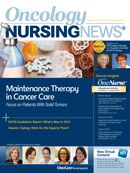What's New From the NCCN? Survivorship Guidelines!
Although the number of survivors is impressive, survivorship also brings challenges, as many cancer survivors experience long-term physical and psychosocial effects of the disease and its treatment.
Lisa Schulmeister, RN, MN, APRN-BC, OCN®, FAAN
Editor-in-Chief OncLive Nursing
Oncology Nursing Consultant, Adjunct Assistant Professor of Nursing Louisiana State Health Sciences Center in New Orleans, Louisiana
Survivorship is the new buzzword in cancer care. In 2012, there were an estimated 13.7 million adult cancer survivors in the United States, and this number is predicted to exceed 18 million in the next decade. The increase in the number of cancer survivors is attributed to earlier detection, an increase in cancer incidence as the population ages, and more effective cancer treatment. Although the number of survivors is impressive, survivorship also brings challenges, as many cancer survivors experience long-term physical and psychosocial effects of the disease and its treatment.
According to the National Coalition of Cancer Survivorship, people are considered cancer survivors from the time of diagnosis through the balance of their lives. Although this definition conflicts with the public perception that survivorship begins when treatment ends, it provides hope and optimism for those diagnosed with cancer, and alerts healthcare providers about the need to initiate a survivorship plan upon an individual’s diagnosis of cancer.
Where to Begin?
There is now an overwhelming amount of information and research findings on survivorship, and the task of sorting it all out is daunting. Fortunately, in March 2013, the National Comprehensive Cancer Network (NCCN) issued its first version of adult Survivorship Guidelines (the Children’s Oncology Group previously issued survivorship guidelines for children).
The NCCN is well recognized for its evidence-based and consensus guidelines on cancer treatment and side-effect management. The survivorship guidelines were designed to provide a framework for managing the long-term and late effects of cancer and its treatment, and encompass the survivor’s health, physical and mental status, health behaviors, and psychosocial needs.
The NCCN recommends a periodic assessment of all survivors to identify their needs, and to identify reversible or contributing causes for symptoms, such as prior cancer treatment, disease status, comorbid conditions, functional status, and medications. The NCCN Survivorship Guidelines include a baseline assessment of concerns: anxiety and depression; cognitive function; exercise; fatigue; immunizations and infections; pain; sexual function; and sleep disorders. A sample survivorship care survey lists 19 questions addressing these key areas, and for each of these key areas, general background information and evidence-based or consensus recommendations are presented.
The information for some of the key areas will be familiar. For exercise, all patients should be encouraged to be physically active. Other sections, such as immunizations and infections, contain less-well-known, detailed information on vaccines and considerations for cancer and transplant survivors. An example is the use of inactivated vaccines (eg, influenza), purified antigen vaccines (eg, pneumococcus), vaccines with bacterial components (eg, DPT), or recombinant vaccines (eg, hepatitis B). The primary concern with the use of these vaccines that do not contain live organisms is whether or not a protective immune response will be generated. NCCN recommends vaccination using usual doses and administration schedules. They caution, however, that the effectiveness of these vaccines may be suboptimal.
Sexual Health and Sleep Disorders
The NCCN Survivorship Guidelines also include a five-question sexual health inventory for men and a four-question sexual symptom checklist for women. These assessment tools are straightforward and easy to complete. Sexual function and health is noted to be integral to an individual’s overall physical and emotional well-being, and the NCCN has included algorithms for responding to sexual health concerns.
Another area of the Survivorship Guidelines that is particularly well done is the section on sleep disorders. In addition to the usual areas of concern, such as insomnia and excessive sleepiness, this section also includes obstructive sleep apnea, restless legs syndrome, and parasomnias (eg, sleepwalking).
The Survivorship Guidelines conclude with a comprehensive list of survivorship resources for healthcare professionals and patients. The list includes the specific survivorship-related programs offered by various organizations and includes website and helpline information.
Back in 2005, the Institute of Medicine and National Research Council delineated essential components of survivorship care. They include prevention of new and recurrent cancers, cancer surveillance, assessment of late physical and psychosocial effects, intervention, and coordination of care. The NCCN Survivorship Guidelines (available at www.nccn.org) are a much-needed step in effectively implementing survivorship care.
Innovative Program Reduces Nurse Turnover and Fosters Development
Published: September 12th 2024 | Updated: September 12th 2024The US Oncology Network (The Network) has developed one of the most comprehensive programs in the nation to support the professional development and retention of new oncology nurses.




